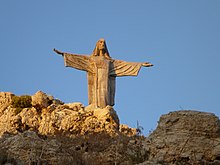Marsalforn
Marsalforn is a village on the north coast of Gozo , the second largest island in the Republic of Malta . It lies between the hills of Xagħra and Żebbuġ and belongs to the municipality of Żebbu Gemeinde . Marsalforn is one of the most popular seaside resorts in Gozo.
Surname
"Marsalforn" is a compound name: "Marsa" comes from Arabic and means "port" or "bay" in German. There are different opinions about the second part of the name: The Maltese word “forn” means “bakery” in German, but it is very unlikely that the place name comes from the fact that a bakery would never have been established in a part of the country with such a small population . It is more likely that it relates to a type of ship - as in other places on Gozo. In this case, the Illyrian word "liburna" (Greek: livurna; Arabic: lifurna) is appropriate. The name can also come from the word "forna", which fishermen from Gozo use to designate a cave formed by the sea. There are quite a few of these caves in Marsalforn; the best known is Għar Qawqla ( Eng .: cave on steep mountain).
history
Marsalforn has a history that goes back to Roman times. Until the 16th century , its port was very important to Gozo. Food from Sicily was unloaded here and passengers to Licata and other ports on mainland Europe embarked here. Marsalforn had grown so much in importance in the late 16th and early 17th centuries that the Knights of St. John - the rulers of Malta at the time - thought of demolishing the old Gozo Citadel in the center of the island and building a new city above Build port. However, the resistance of the people of Gozo meant that these plans were never realized. People alleged that they were too poor to pay additional taxes to finance the move and that the circumstances were too great for them to move from Victoria Rabat to Marsalforn. With the development of Mġarr as a ferry port between Gozo and Malta and the construction of defense towers to protect the waterway between Gozo and Malta, Marsalforn lost its importance and remained a quiet fishing village for many centuries, where only fishermen and their families lived.
economy
The development of tourism in the Maltese islands in the 20th century led the economic development of the village away from fishing. Although fishing still plays a certain role today, tourism provides most of the jobs for the residents. The place has a short sandy beach with a promenade behind it, on which there are many hotels, restaurants and apartment houses. Furthermore, the place is one of the most famous diving areas in Gozo, consequently you will find many diving schools and diving centers here .
In the last thirty years there has been a real urbanization and the place expanded along the crescent-shaped bay to Qbajjar . The growing tourism led to the construction of a number of hotels, guest houses and apartment houses. In addition, the desire of many wealthy Maltese and Gozo residents for a second home in Marsalforn and the involvement of foreign investors led to an increased demand for land.
One effect of tourism is a noticeable seasonal change in the character of the village. In winter, when there are few tourists and many second homes are not used, it is quiet and peaceful. In the summer, on the other hand, the village is a busy place full of Maltese and foreign visitors.
Attractions

In the south of Marsalforn lies a fertile valley of the same name. It is surrounded by a number of rock bars. The best known is Tal-Merżuq (German: Hill of the Light Beam ), on which the statue Tas-Salvatur stands. As recorded in the Acts of the Apostles , the Apostle Paul was stranded in Malta, and legend has it that he set out from Marsalforn on his journey to Sicily and Rome . This legend is still referred to in the village coat of arms, which shows a snake curled around a sword. This is reminiscent of the episode of Paul who is said to have survived the bite of a poisonous snake unscathed.
The village church is also the shipwreck of St. Consecrated to Paul. Originally created in the 14th century , it has been expanded several times. The foundation stone of today's church was laid in 1730. The village festival is celebrated on February 10th.
Individual evidence
- ^ A b Joseph Bezzina: Marsalforn Culture & History. Iż-Żebbuġ Kunsill Lokali, 2013, accessed on October 13, 2019 .
- ^ Brian Blouet: The story of Malta . Progress Press Co., Malta 1981, p. 101.
Web links
Coordinates: 36 ° 4 '15.89 " N , 14 ° 15' 34.99" O




